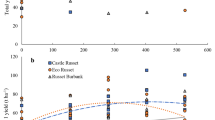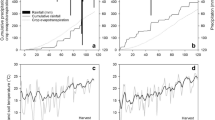Abstract
Potato tuber tissue is low in calcium as compared to leaves and stems. Several recent studies have provided evidence linking tuber quality with tuber tissue Ca concentration. The purpose of the present study was to determine the influence of supplemental Ca and N fertilization on tuber Ca concentration and internal brown spot of potato. Three soluble products (calcium nitrate, calcium chloride, and N-Plus; 9N:0K:0P:11Ca) were used as Ca sources with and without gypsum. In addition, a combination of calcium chloride, urea, and calcium nitrate (CUC) was also used without gypsum. Each treatment consisted of five replications, which received the same total amount of N (252 kg ha−1) supplied either alone or in various combinations of ammonium nitrate, urea, calcium nitrate, calcium chloride, and N-Plus. The soluble sources of Ca were added at 68.8 to 168.0 kg ha−1 while gypsum supplied Ca at 49 kg ha−1. The application of all N by hilling (non-split) was compared to split application of N and Ca at hilling and 2, 4, and 6 wk after hilling. Tubers were mechanically harvested and graded according to industry standards. About 100 U.S. No. 1 tubers from each replication were cut in half along the longitudinal axis and visually inspected for internal defects. From each replication, non-periderm tissue from 15 tubers was combined for Ca analysis. There was no treatment effect on tuber yield in both years. Application of gypsum, either alone or in combination with the soluble sources, was not effective in reducing incidence of internal brown spot (IBS). Furthermore, with one exception, application of gypsum either alone or in combination with soluble sources of Ca was not effective at increasing tuber tissue Ca concentration. Combined analyses of data from 2 years showed that the application of soluble sources of Ca without gypsum increased tuber Ca concentration and decreased the incidence of IBS. Furthermore, split application of N had similar beneficial effects as compared to non-split N. Data from 1997 (a year with high IBS) gave a significant inverse relationship between tuber Ca and IBS, suggesting that an increase in tuber Ca can reduce IBS incidence.
Resumen
El tejido del tubérculo de papa contiene poco calcio en comparación con las hojas. Diversos estudios recientes proporcionan evidencia relacionando la calidad del tubérculo con la concentración de Ca. El propósito del presente estudio fue determinar la influpropósito del Ca suplementario y fertilización nitrogenada sobre la concentración de Ca y presencia de mancha parda en el tubérculo de papa. Se utilizaron tres productos solubles (nitrato de calcio, cloruro de calcio y N-Plus; 9N: OK: OP: 11Ca) como fuente de calcio con y sin yeso. También se utilizó una combinación de cloruro de calcio, urea y nitrato de calcio (CUC) sin yeso. Cada tratamiento consistió de cinco repeticiones que recibieron la misma cantidad total de N (252 Kg ha−1) aplicada solo o en varias combinaciones de nitrato de amonio, urea, nitrato de calcio, cloruro de calcio y N-Plus. Las fuentes solubles de Ca se añadieron entre 68.8 y 168.0 Kg ha−1 mientras que el yeso suministró Ca a razón de 49 Kg ha−1. La aplicación de todo el N total (sin fraccionar) fue comparada con laaplicación fraccionada de N y Ca al aporque y 2, 4 y 6 semanas después del aporque. Los tubérculos fueron cosechados mecánicamente y clasificados de acuerdo a los estándares industriales. Alrededor de 100 tubérculos US#1 de cada repetición se cortaron a lo largo del eje longitudinal y fueron inspeccionados visualmente para defectos internos. De cada réplica, se combinó el tejido sin peridermo de 15 tubérculos para el análisis de Ca. No hubo efecto de tratamiento sobre el rendimiento de tubérculos en ambos años. Las aplicaciones de yeso solo o en combinación con fuentes solubles de Ca no fueron efectivas para reducir la incidencia de mancha parda interna (IBS). Más aún, con una sola excepción, la aplicación de yeso solo o en combinación con fuentes solubles de Ca sin yeso no fue efectiva para incrementar la concentración de Ca del tejido del tubérculo. El análisis combinado de datos de dos años demostró que la aplicación de fuentes solubles de Ca sin yeso, incrementaron la concentración de Ca del tubérculo y disminuyeron la incidencia de IBS. Más aún, la aplicación fraccionada de N tuvo efecto benéfico similar en comparación con el N no fraccionado. Los datos de 1997 (año con alta incidencia de IBS) dieron una significativa relación inversa entre el Ca del tubérculo e IBS, sugiriendo que un incremento en el Ca del tubérculo puede reducir la incidencia de IBS.
Similar content being viewed by others
Literature cited
Bangerth F. 1979. Calcium-related disorders of plants. Ann Rev Phytopathol 17:97–122.
Bell CW and O Biddulph. 1963. Translocation of calcium, exchange versus mass flow. Plant Physiol 38:601–614.
Collier GF, DCE Wurr and VC Huntington. 1978. The effect of calcium nutrition on incidence of internal rust spot in potatoes. J Agric Sci 91:241–243.
Collier GF, DCE Wurr and VC Huntington. 1980. The susceptibility of potato varieties to internal rust spot in the potato. J Agric Sci 94:407–410.
Gunter C, S Ozgen, B Karlsson and JP Palta. 2000. Calcium application at preemergence and during bulking may improve tuber quality and grade. HortScience 35:498.
Karlsson B, JP Palta and S Ozgen. 2001. Reduction of potato tuber bruising and internal defects by supplemental calcium field application. Amer J Potato Res 78:462.
Kleinhenz MD, JP Palta, CC Gunter and KA Kelling. 1999. Impact of source and timing of calcium and nitrogen on ‘Atlantic’ potato tuber calcium concentrations and internal quality. J Amer Soc Hort Sci 124(5): 498–506.
Kratzke MG and JP Palta 1985. Evidence for the existence of functional roots on potato tubers and stolons: Significance in water transport to the tubers. Am Potato J 62:227–236.
Kratzke MG and JP Palta 1986. Calcium accumulation in potato tubers: Role of basal roots. HortScience 21:1022–1024.
Levitt J. 1942. A histological study of hollow heart potatoes. Am Potato J 19:134–143.
Liegel EA, CR Simson and EE Schulte. 1980. Wisconsin soil testing, plant analysis and feed and forage analysis procedures. Soil Fertility Series 6. Dept of Soil Sci., Univ. of Wisconsin, Madison.
Marschner H. 1995. Mineral Nutrition of Higher Plants. Academic Press, London. pp 285–299.
McCann IR and JC Stark. 1989. Irrigation and nitrogen management effects on potato brown center and hollow heart. HortScience 24:950–952.
Ojala JC, JC Stark and GE Kleinkopf. 1990. Influence of nitrogen and irrigation management on potato yield and quality. Am Potato J 67:29–43.
Palta JP. 1996. Role of calcium in plant responses to stresses: Linking basic research to the solution of practical problems. Proceedings of Colloquium: Recent advances in plant responses to stress: Bridging the gap between science and technology. HortScience 31:51–57.
Simmons KE and KA Kelling. 1987. Potato responses to calcium application in several soil types. Am Potato J 64:119–136.
Simmons KE, KA Kelling, RP Wolkowski and A Kelman. 1988. Effect of calcium source and application method on potato yield and cation composition. Agron J 80:13–21.
Stark JC, IR McCann, DT Westermann, B Izadi and TA Tindall. 1993. Potato response to split nitrogen timing with varying amounts of excessive irrigation. Am Potato J 70:765–777.
Tawfik AA and JP Palta. 1992. Practical means of enhancing tuber calcium content and reducing incidences of soft rot and internal brown spot by application of soluble form of calcium during bulking. HortScience 27:665.
Tisdale SL, WL Nelson, JD Beaton and JL Havlin. 1993. Soil Fertility and Fertilizers. Prentice-Hall, Englewood Cliffs, NJ. pp 90–91.
Tzeng KC, A Kelman, KE Simmons and KA Kelling. 1986. Relationship of calcium nutrition to internal brown spot of potato tubers and subapical necrosis of sprouts. Am Potato J 63:87–97.
Author information
Authors and Affiliations
Corresponding author
Rights and permissions
About this article
Cite this article
Ozgen, S., Karlsson, B.H. & Palta, J.P. Response of potatoes (cv russet burbank) to supplemental calcium applications under field conditions: Tuber calcium, yield, and incidence of internal brown spot. Am. J. Pot Res 83, 195–204 (2006). https://doi.org/10.1007/BF02872155
Accepted:
Issue Date:
DOI: https://doi.org/10.1007/BF02872155




